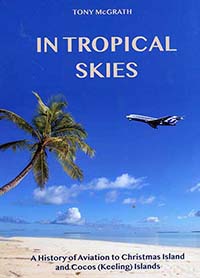A pictorial history of this Indian Ocean island airport which played an important role in international air services
Compiled by Geoff Goodall

Qantas Lockheed Super Constellation VH-EAI "Southern Sun" being refuelled at Cocos Islands Airport circa 1957
operating the scheduled service between Sydney and Johannesburg. Photo: Civil Aviation Historical Society
operating the scheduled service between Sydney and Johannesburg. Photo: Civil Aviation Historical Society
Cocos Islands' location halfway between Perth and Ceylon (Sri Lanka) resulted in a Cable Station being built in 1901 with telegraphic links to Perth, Ceylon, Batavia (Jakarta), Singapore and Mauritius via undersea cable. As one of the few populated islands across the northern Indian Ocean, its strategic importance for international air travel was recognised by pioneer Australian aviator Captain P.G.Taylor who lobbied the Government to finance an expedition to survey a flying boat route from Australia to East Africa and Britain in the event the existing route via Singapore was cut. His prediction was to prove correct when Singapore fell to Japanese attack in January 1942, however no action had had been taken on his recommendations to establish airline flying boat facilities in Western Australia and Cocos.
P. G. Taylor's Indian Ocean survey flight in June 1939 was the first aeroplane to be seen at Cocos Islands. It was a Consolidated 28-3 flying boat, civil predecessor to the military PBY- Catalina series. NC777 named Guba was owned by Dr. Richard Archbold of New York and was in Sydney following an American Museum of Natural History Expedition in New Guinea. Using his considerable personal influence, Captain Taylor negotiated to hire NC777 with its American crew for his Indian Ocean survey for which he would be the navigator.
The epic expedition flew Sydney-Port Hedland-Batavia-Cocos Islands-Diego Garcia-Mahe, Seychelles-Mombassa, Kenya.
At Cocos the flying boat was landed on a lagoon off Direction Island and Taylor spent a week surveying sites for flying boat operations and a land airfield.

First aircraft to visit Cocos was this Consolidated 28-3 flying boat NC777 "Guba"on an Indian ocean survey flight June 1939.
It is pictured at Williamstown boat harbour while visiting Melbourne the previous November to have its troublesome Sperry
auto-pilot serviced by Australian National Airways instrument technicians. Photo: Civil Aviation Historical Society
It is pictured at Williamstown boat harbour while visiting Melbourne the previous November to have its troublesome Sperry
auto-pilot serviced by Australian National Airways instrument technicians. Photo: Civil Aviation Historical Society
Qantas Empire Airways commenced its secret wartime Order of The Double Sunrise Catalina service Perth-Ceylon non-stop (average flight time 29 hours) in June 1943. The Indian Ocean crossing was done in radio silence and although passing close to Cocos Islands, landing there was too great a risk from Japanese air patrols. Nevertherless four landings are recorded by the QEA Catalinas to drop off or collect essential personnel. On one of these visits in February 1944 QEA Catalina G-AGFL was caught on the lagoon by a Japanese reconnaissance aircraft which dropped several bombs which fell wide of their mark.
When the construction was nearing completion, on 29 June 1945 Allied Air Commander South East Asia, Air Marshall Sir Keith Park arrived from India by RAF Sunderland to inspect the new airfield and talks with the Clunies-Ross family to finalise the terms for the use of West Island as an airfield. The first operational sortie was made on 3 July when a RAF Mosquito squadron began photo-reconnaisance missions over Sumatra, Malaya and Singapore.
RAF Liberator, Spitfire and Catalina units also operated there. A detachment of RAAF No.87 Squadron Mosquitos was based at Cocos during June 1945 for photo-reconnaissance missions over Singapore. Following V-J Day, British operations were withdrawn and the airfield was decommissioned in early 1946.
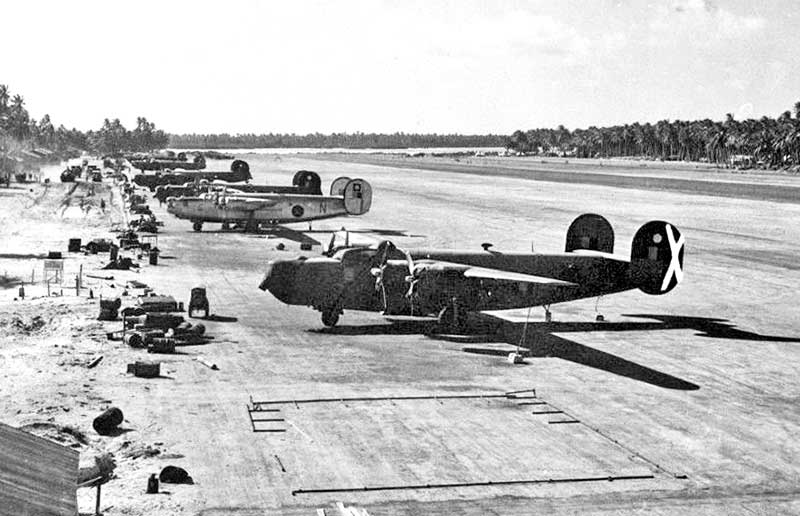

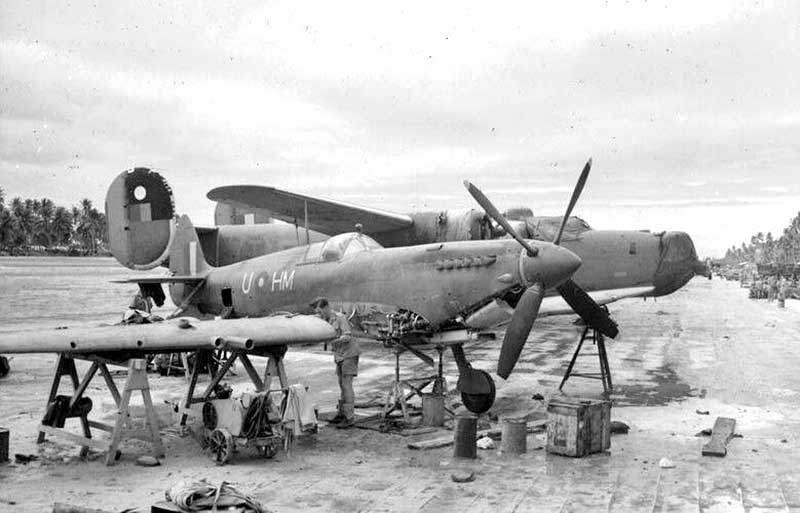
BOAC and Qantas Empire Airways were
anxious to renew their shared London-Sydney service cut by the war.
The previous 9 day Short C Class "Empire" flying boat schedule could be
reduced to a third of that time by using high speed Avro Lancastrians.
The Lancastrian service commenced in June 1945, QEA crews flying
Sydney-Gawler-Learmonth-Colombo-Karachi. The newly-built Cocos Islands
RAF airfield was a comforting alternate for the Indian Ocean crossing
and became a scheduled refuelling stop in January 1946 when routing
changed to Karachi-Colombo-Cocos-Perth-Gawler-Sydney.
QEA Liberators G-AGKT, G-AGKU and G-AGTI supplemented the Lancastrians with a Sydney-Perth-Cocos-Colombo return weekly schedule. This interim Indian Ocean route was scheduled to finish in April 1946 when war damage renovations allowed Qantas to resume the original Kangaroo route via Darwin and Singapore with more comfortable airliners. Tragically one of the very last Lancastrian services was lost between Colombo and Cocos Islands: on 24 March 1946, G-AGLX under the command of highly experienced QEA Captain O.F.Y. Thomas lost radio contact and no trace has ever been found of the aircraft or the ten persons on board.
QEA Liberators G-AGKT, G-AGKU and G-AGTI supplemented the Lancastrians with a Sydney-Perth-Cocos-Colombo return weekly schedule. This interim Indian Ocean route was scheduled to finish in April 1946 when war damage renovations allowed Qantas to resume the original Kangaroo route via Darwin and Singapore with more comfortable airliners. Tragically one of the very last Lancastrian services was lost between Colombo and Cocos Islands: on 24 March 1946, G-AGLX under the command of highly experienced QEA Captain O.F.Y. Thomas lost radio contact and no trace has ever been found of the aircraft or the ten persons on board.

Avro Lancastrian G-AGLS (in temporary RAF markings VD328 radio callsign OKZS) arrives Sydney 17 April 1945 on delivery to Qantas.
Lancastrians operated a fast 5 day mail and passenger service to London after the route had been cut during WWII.
John Hopton Collection
Lancastrians operated a fast 5 day mail and passenger service to London after the route had been cut during WWII.
John Hopton Collection
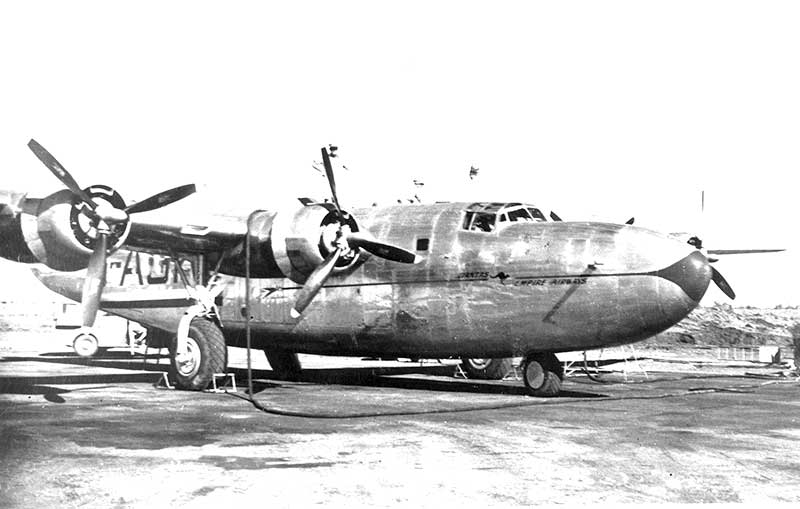
An initial route proving flight was conducted by Captain Lewis Ambrose in Lancastrian VH-EAS in November 1948, carrying a party of Qantas, DCA, MET and Shell Oil Co officials. Prior to the flight, senior QEA Captain R.B.Tapp was taken from Singapore to Cocos by RAF Sunderland flying boat to inspect the disused runway. He reported that the metal PSP matting was badly rusted with vegetation growing through and recommended the Lancastrian use the parallel taxiway which ran in front of the Tower building. Flight Navigator Jim Cowan later recalled:
"When we did touch down at Cocos, as we hurtled down the narrow coral-paved taxiway I was sure we were going to strip our wingtip off against the old RAF Control Tower. However there was plenty of room and our landing run was without incident. Our stay at Cocos proved a great experience because, with the total absence of staff or accommodation, we stayed at "Government House", the Clunies-Ross homestead on Home Island. That evening our Lancastrian party of 12 sat down with the Cable Station personnel as guests for a magnificent Indonesian curry repast served by a retinue of well-ordered servants. I remember the excited faces of the people outside peering through the open sash windows into the dining room. Next morning we watched a flotilla of 50 to 100 white-sailed dugout canoes sail off across the lagoon in various directions to commence the day's work in the vast coconut plantations that covered the islands.
The Lancastrian crew were taken by boat to the Cable Station on Direction Island to obtain the aviation weather forecast and transmit their flight plan for the next sector to Mauritius. While they refuelled the aircraft from 44 gallon drums using a hand wobble-pump, Captain Ambrose inspected the PSP runway and was satisfied it was safe to use. VH-EAS departed that night with flares down each side of the runway. The proving flight continued to Johannesburg for a week's talks with Government officials before returning to Sydney via Cocos, taking 81 flying hours, 29 hours at night. The Lancastrian and its Rolls Royce Merlins had performed flawlessly.
To assess the scope of work required, Qantas was chartered to carry a team of RAAF and DCA airfield construction officials to Cocos. The wartime runway was considered to be unserviceable so a Qantas Consolidated PB2B-2 Catalina flying boat VH-EBA was prepared for the flight. Because aviation fuel was not available at Cocos, the route was Sydney (Rose Bay)-Brisbane-Darwin-Djakarta-Cocos-Djakarta-Australia, to allow sufficient fuel to be taken on at Djakarta for the return flight to Cocos. The Catalina departed Sydney on 25 May 1951 under the command of Captain Len Grey. The outbound flight required a pre-dawn flare path takeoff from Darwin Harbour. The party remained at Cocos 30 May-12 June while the airfield survey was carried out.
Later in 1951 the RAAF construction group with heavy earthmoving equipment was deployed to Cocos by sea from Perth to
West Island where 7,000 tons of equipment and supplies were manually unloaded by landing barges.
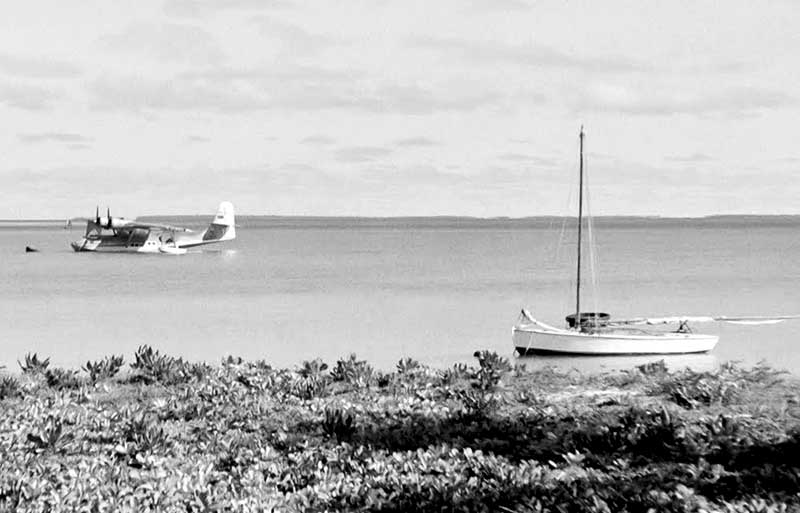
construction party to survey the disused airfield to assess the works needed to upgrade it for international airline use.
Photo: Civil Aviation Historical Society


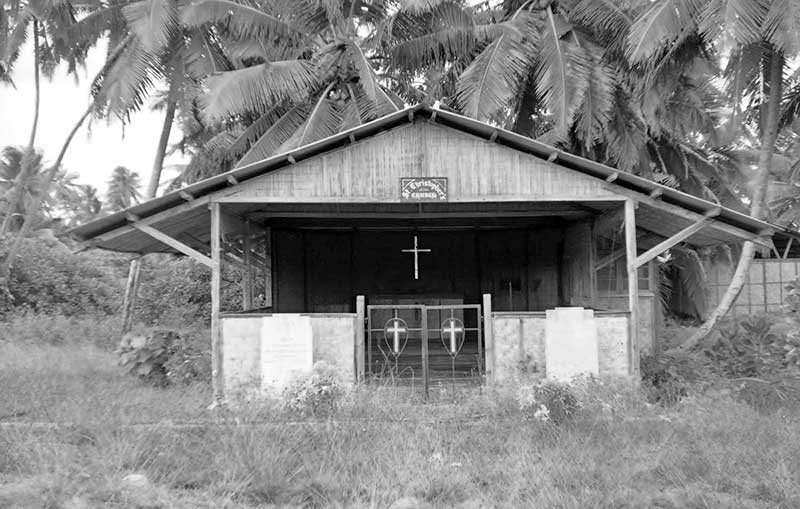

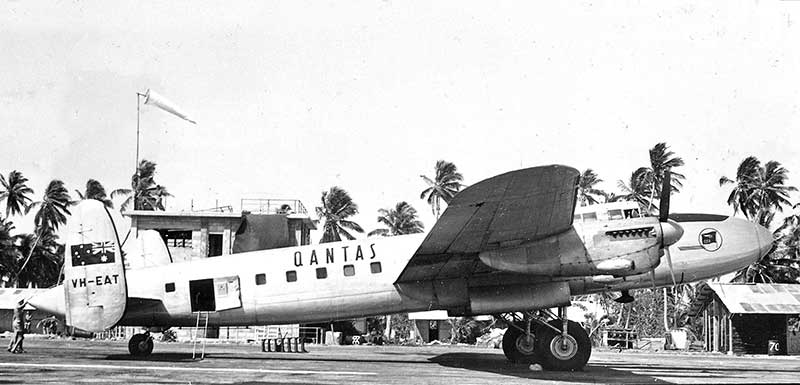
Qantas Heritage Centre
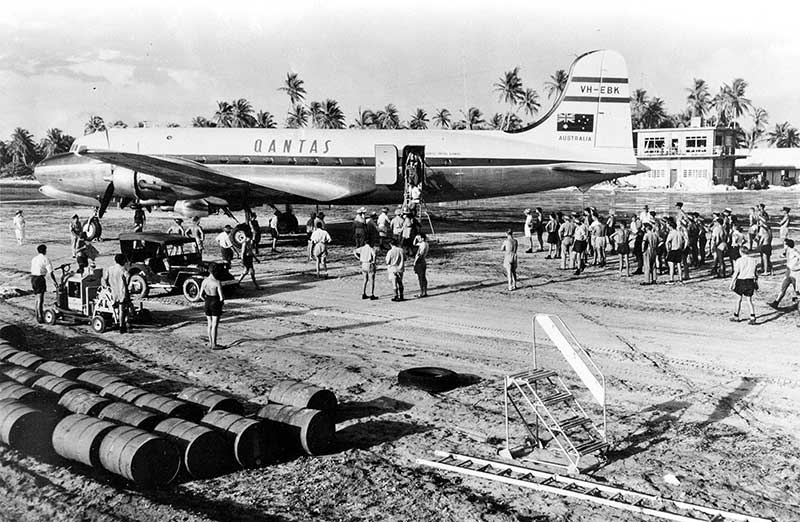
After the runway was completed, construction continued on taxiways, buildings and the many installations required for an
international airport. From March 1952 Qantas operated a fortnighty DC-4 charter Melbourne-Perth-Cocos-Singapore
return, carrying personnel and supplies for the airfield construction group. Civil Aviation Historical Society
international airport. From March 1952 Qantas operated a fortnighty DC-4 charter Melbourne-Perth-Cocos-Singapore
return, carrying personnel and supplies for the airfield construction group. Civil Aviation Historical Society
Shortly after, when the fortnightly DC-4 charter courier Perth-Cocos-Singapore return was discontinued, Qantas changed the route to a sheduled airline service Perth-Cocos-Djakarta-Singapore return, connecting with the South Africa service at Cocos.
Cocos Islands Airport settled down to a routine of transiting Qantas flights and occasional visiting aircraft making refuelling stops.
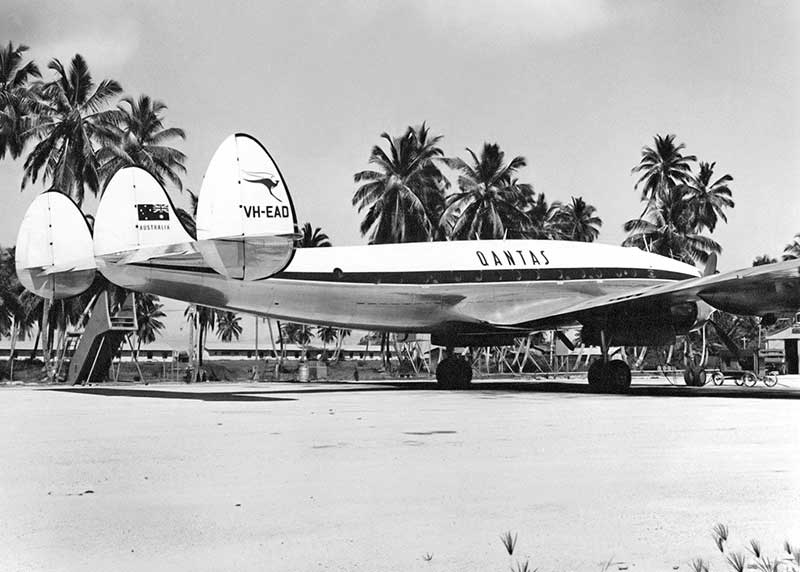
The passenger hostel can be seen in this view at Cocos. Richard Harrington via Civil Aviation Historical Society
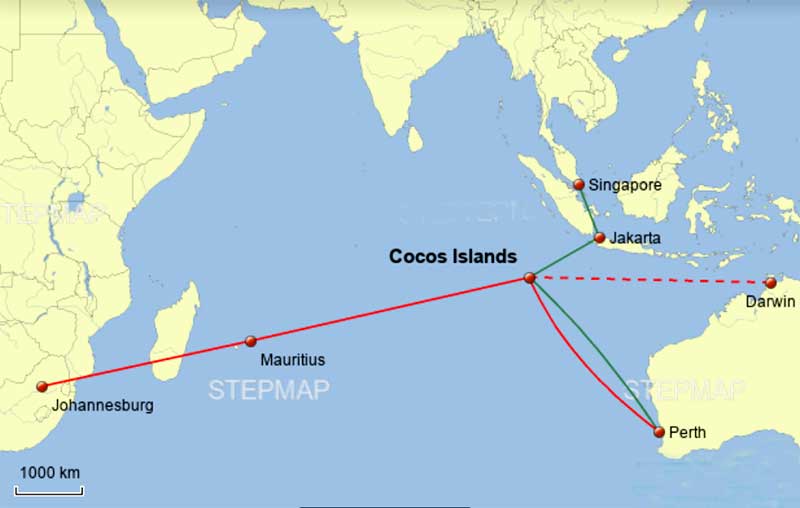
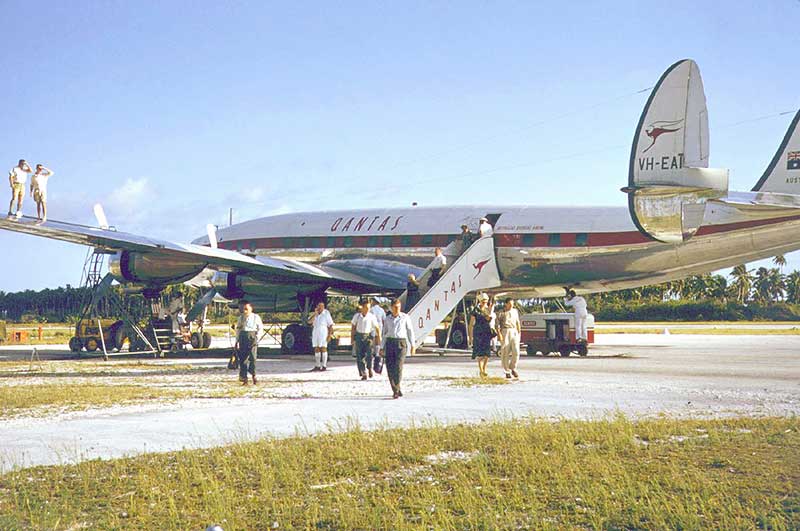
Here passengers disembark from VH-EAI "Southern Sun"on an early morning arrival at Cocos. CAHS
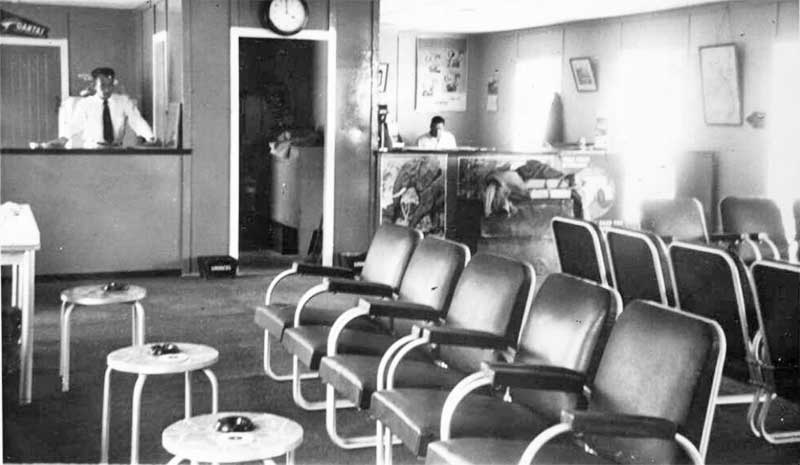
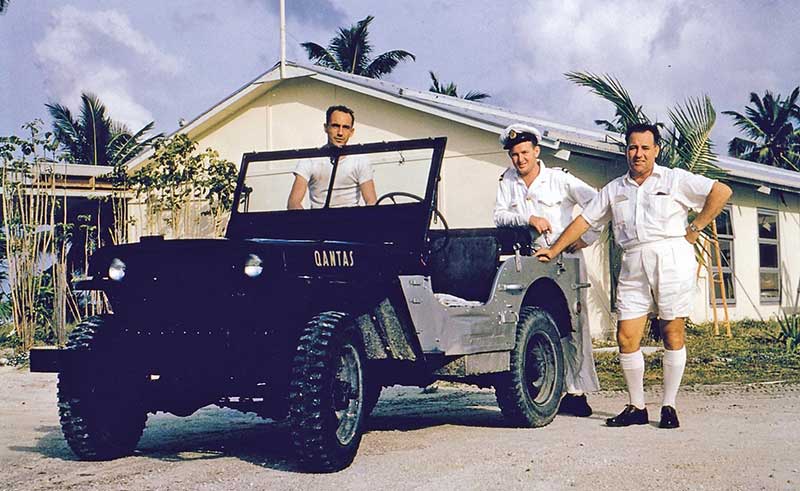
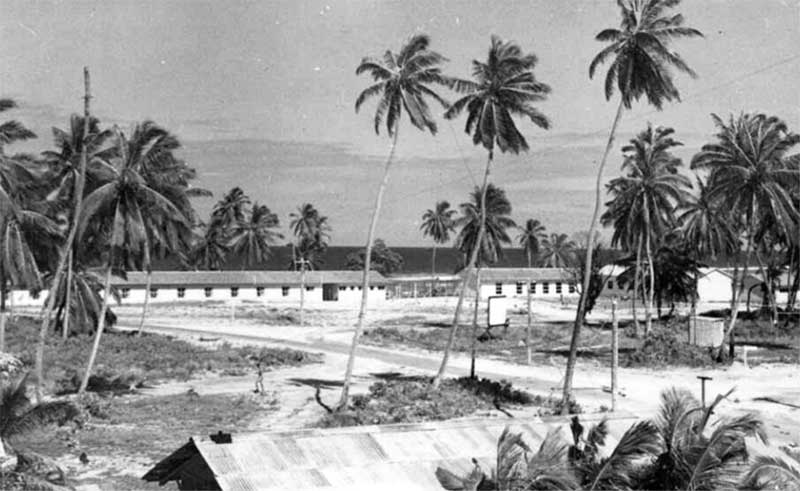
delayed by unserviceability or weather. The hostel included a kitchen and dining room.
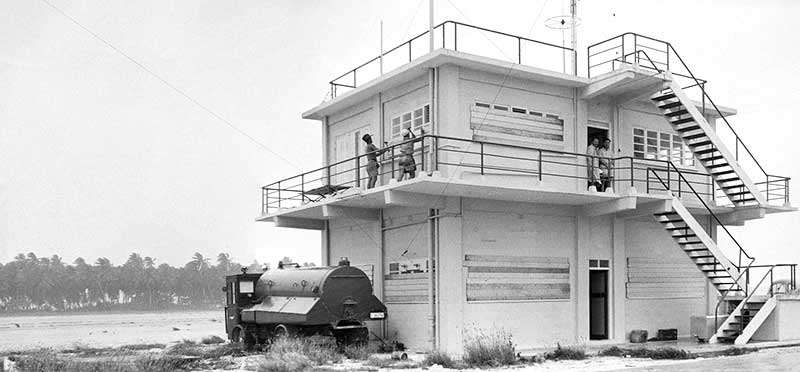
Tower cab was removed. Here the windows are being boarded over in driving rain from an approaching cyclone. CAHS


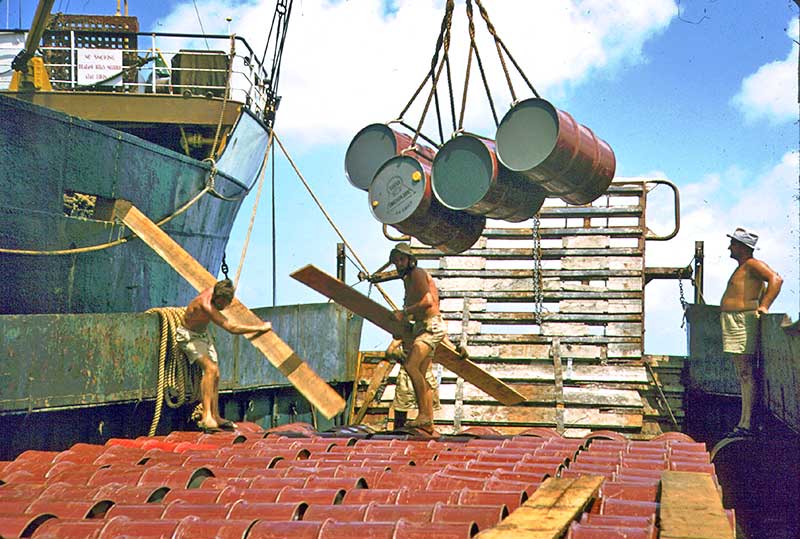
Photo by Alan Jenkins via CAHS
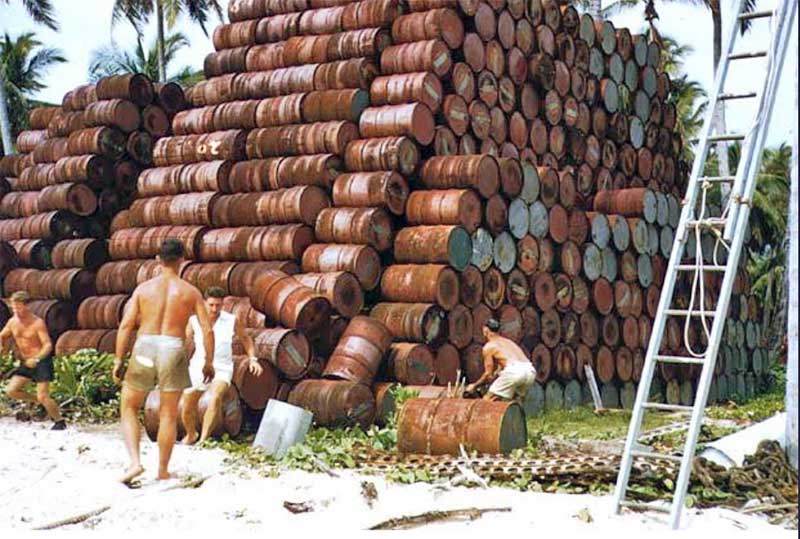
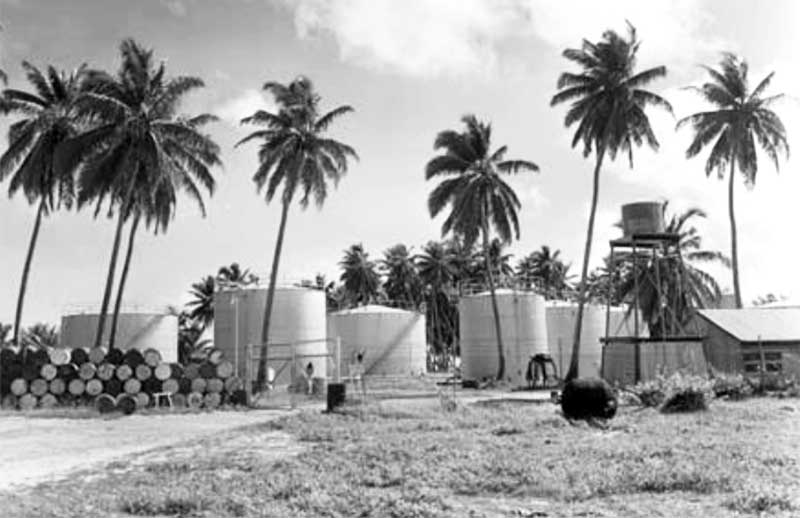
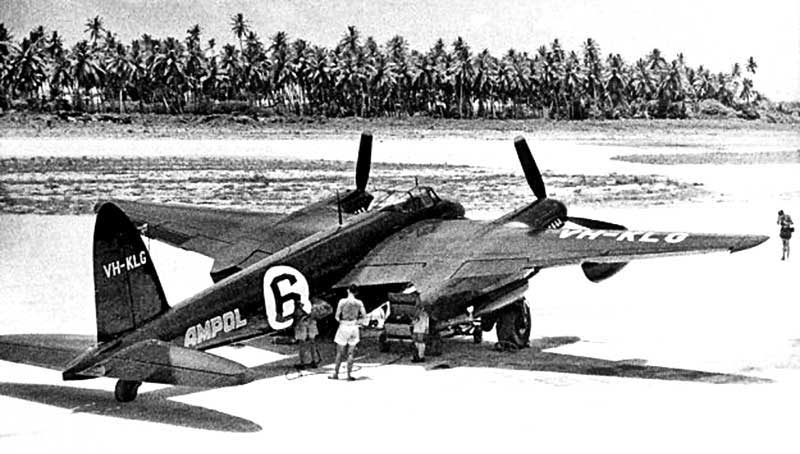
It was to be wrecked in a forced landing in Burma later that same day. All air race competitors stopped at Cocos where they
were expedititiously handled by a RAF refuelling team sent from Singapore. Photo: Max Mead
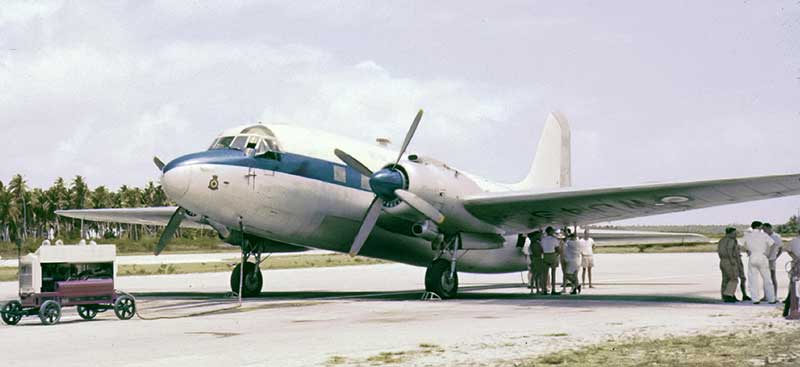
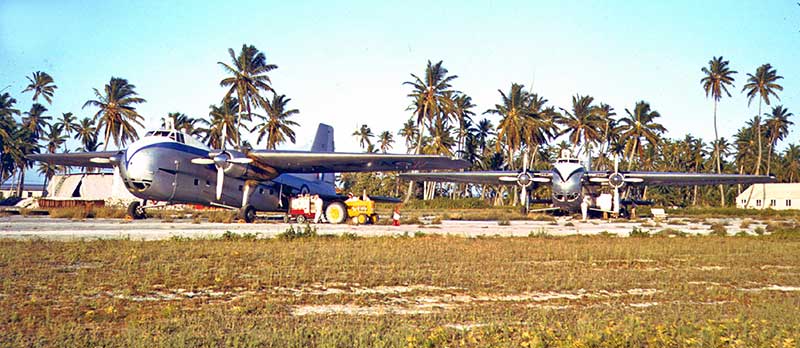
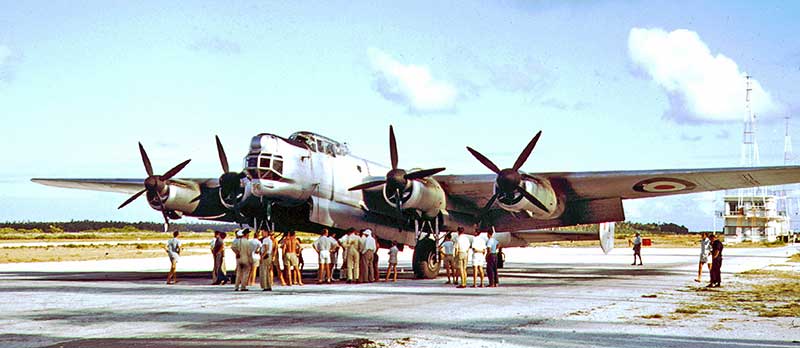

The General, Madame de Gaulle and their party stayed overnight at the Qantas hostel. Alan Jenkins via CAHS
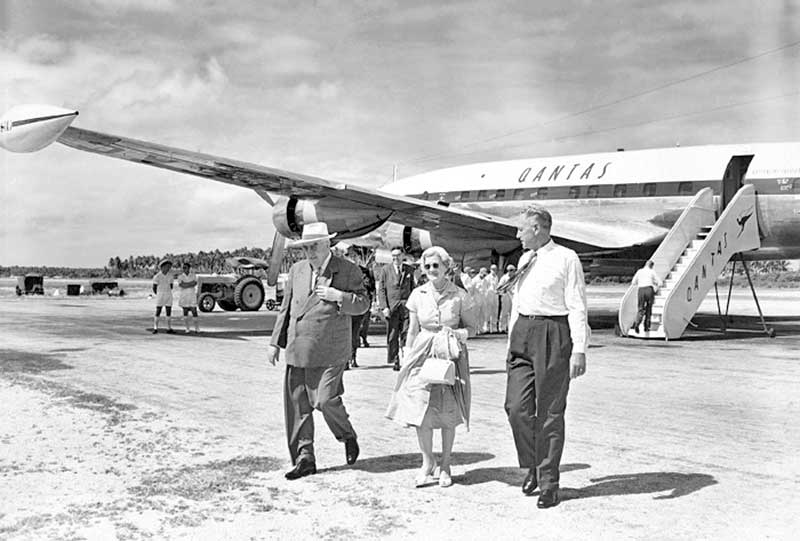
The number of itinerant flights using Cocos was increasing as international air charter and air freight grew.
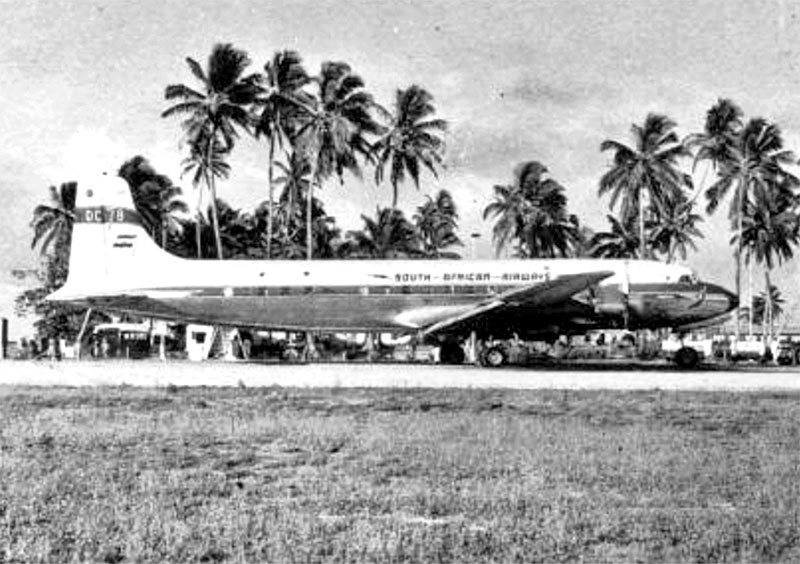
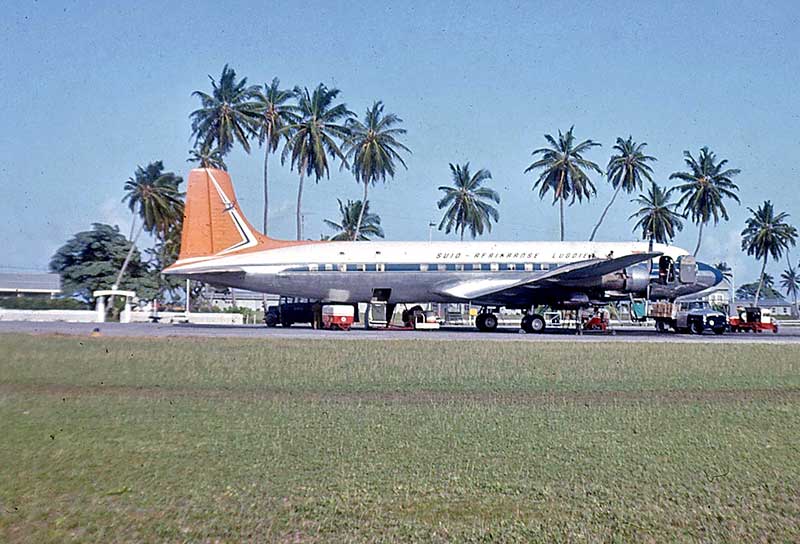
who went for a stroll during a Cocos refuelling stop, enroute Johannesburg to Perth then Sydney. Photo via Peter Norman
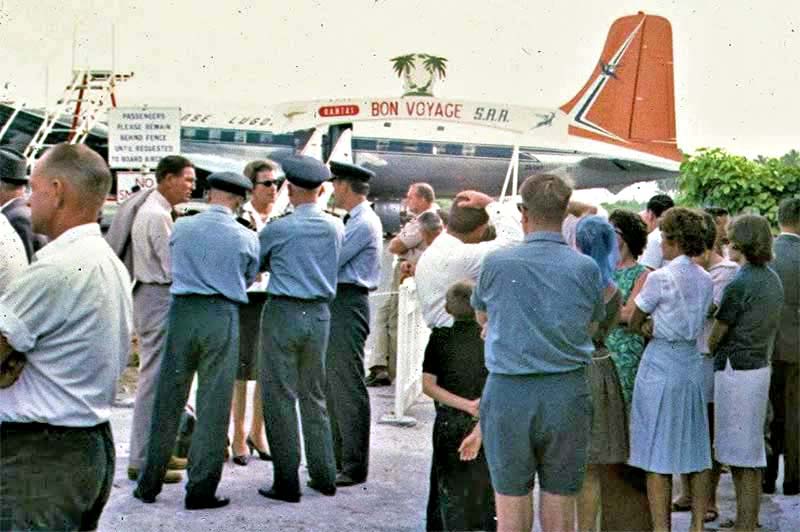
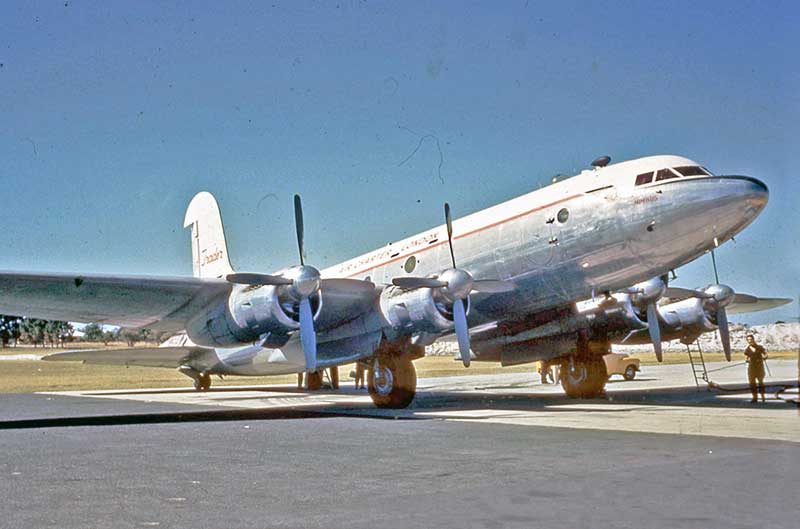
From 1956 Air Charter Ltd, London operated a weekly British Ministry courier between London and Woomera Rocket Range
in
South Australia, initially using Avro Tudor 4B Super Traders.
Most services routed via Singapore and Darwin, but when
required by weather or sensitive military cargo, they skirted Indonesia by flying Colombo-Cocos-Australia. Here Air Charter
Tudor G-AHNL is seen at Perth in December 1958 after arrival from Britain via Cocos. Geoff Goodall collection.
required by weather or sensitive military cargo, they skirted Indonesia by flying Colombo-Cocos-Australia. Here Air Charter
Tudor G-AHNL is seen at Perth in December 1958 after arrival from Britain via Cocos. Geoff Goodall collection.
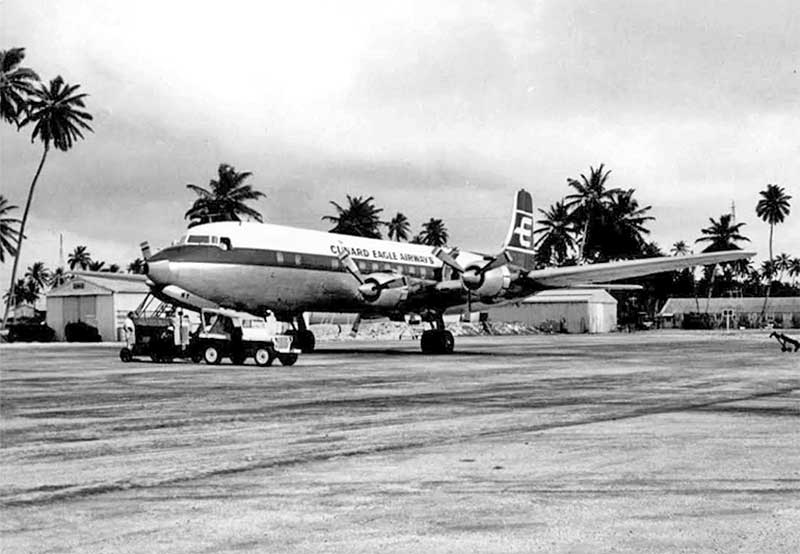
The following year the airline reformed as British Eagle and introduced Bristol Britannias on the Woomera contract
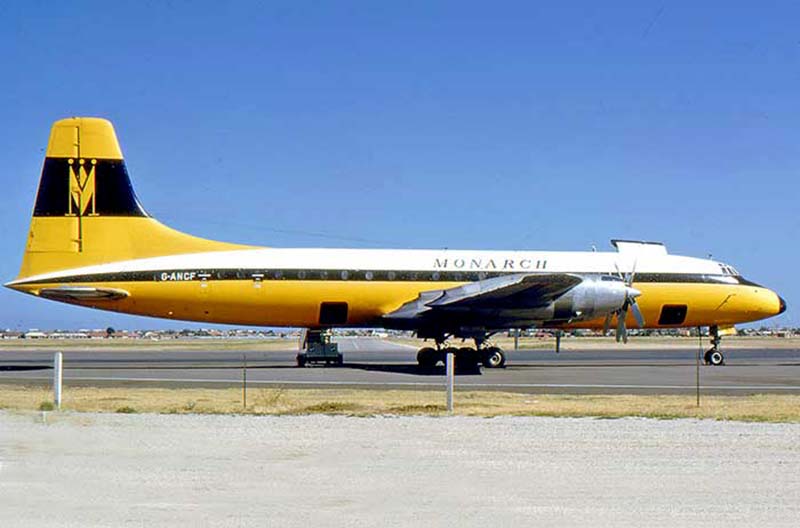
stops at Cocos or RAF Gan in the Maldives. Nigel Daw photographed G-ANCF at Adelaide on the courier run in April 1972.
The British Ministry courier to Australian was discontinued in December 1975 because of reduced Woomera projects.
During 1967 both Qantas and SAA introduced Boeing 707 jet airliners which could fly between Perth and Mauritius direct. This allowed Cocos Islands Airport to be dropped as an airline port and the removal of airline personnel, equipment and facilities at a significant cost saving. Qantas ended their Cocos services in April 1967, SAA the previous month. Earlier, to cover a period of DC-7B unavailability, SAA leased Trek Airways Lockheed L.1649 Starliner ZS-DVJ to operate SAA Johannesburg-Perth services via Cocos between 7 May and 28 September 1965.
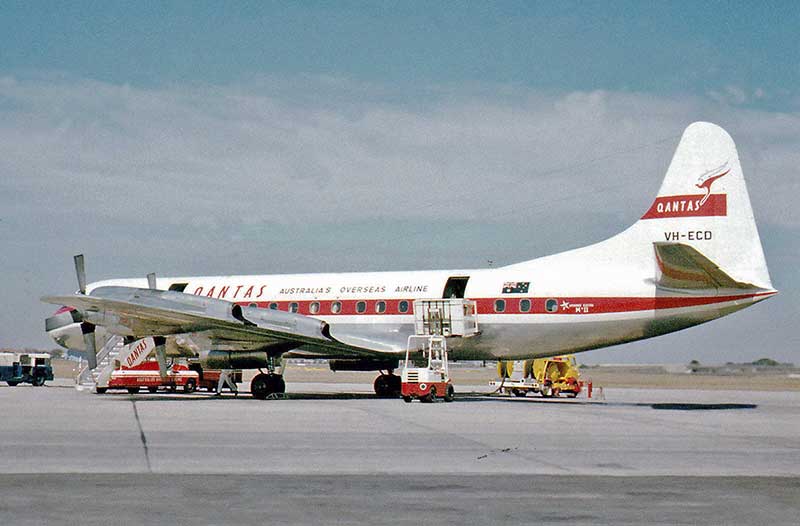
Ian McDonell collection
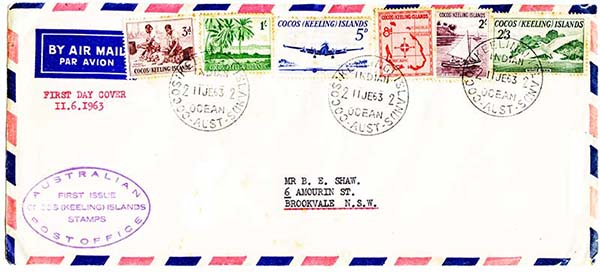
Constellations to island life. First day cover courtesy Phil Vabre
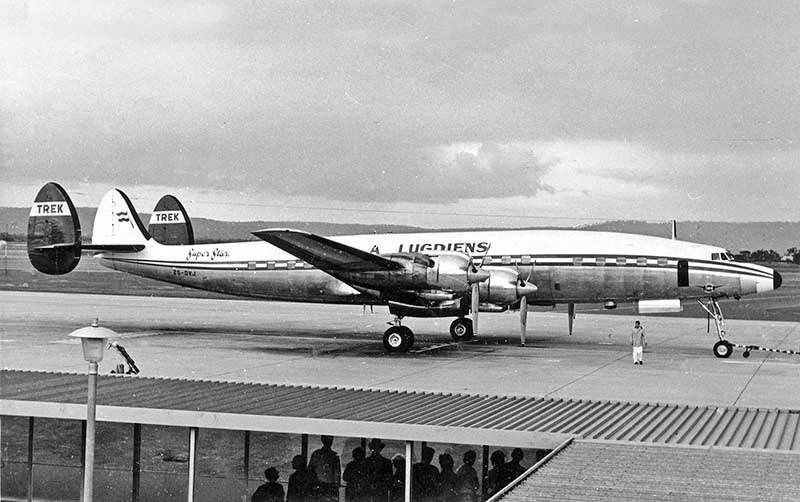
This ultimate model of the Constellation range was photographed at Perth Airport in July 1965 by Merv Prime.

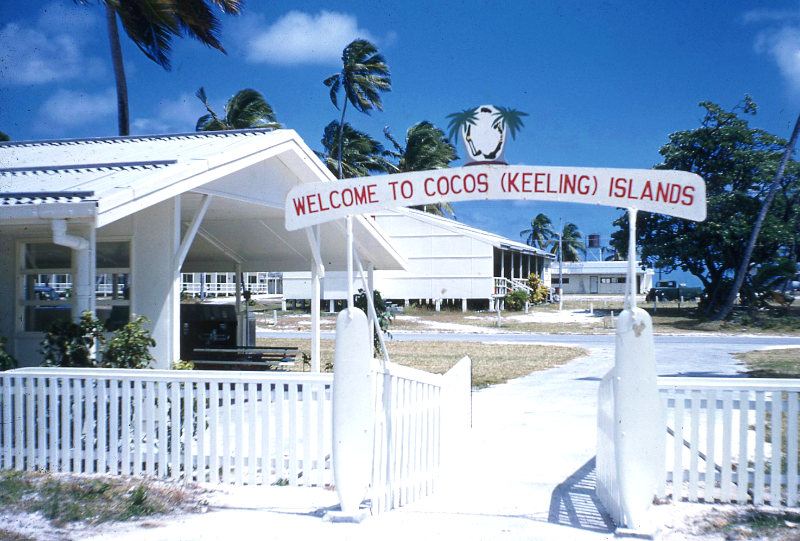
Leigh Ryan sent these two photos he took during a Cocos refuelling stop on a RAAF C-130A Hercules flight from Butterworth, Malaya to
Australia in the early 1960s. During refuelling they were free to cross the runway to enjoy the scene on the island coastline
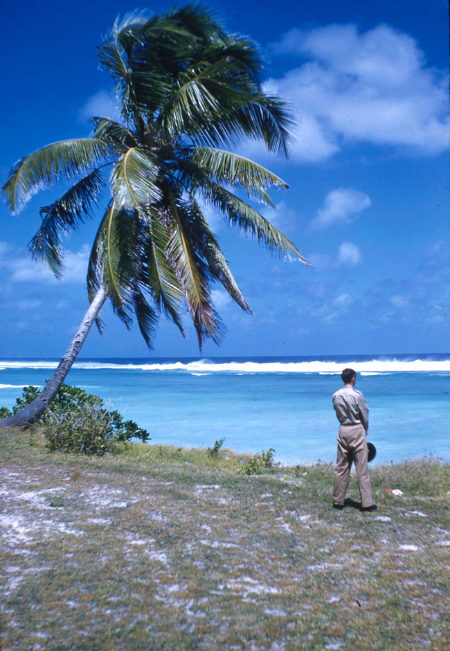
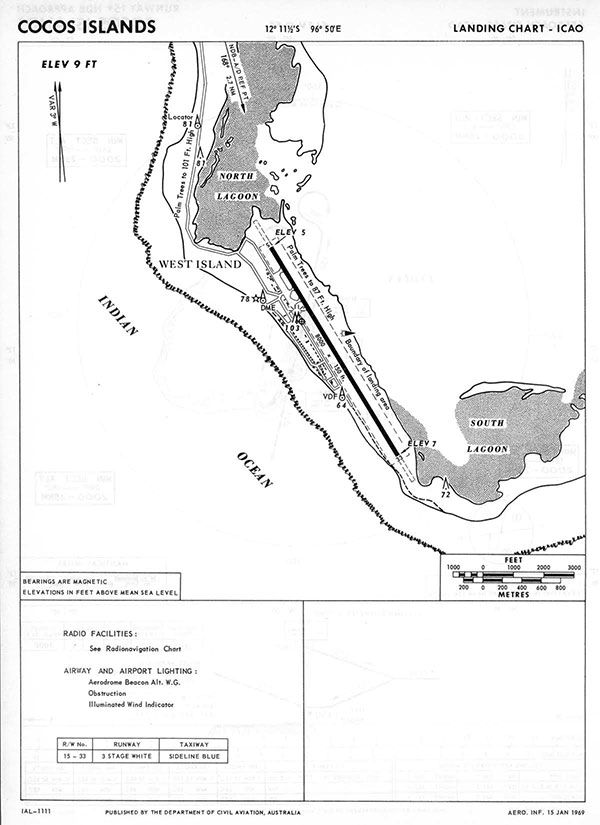
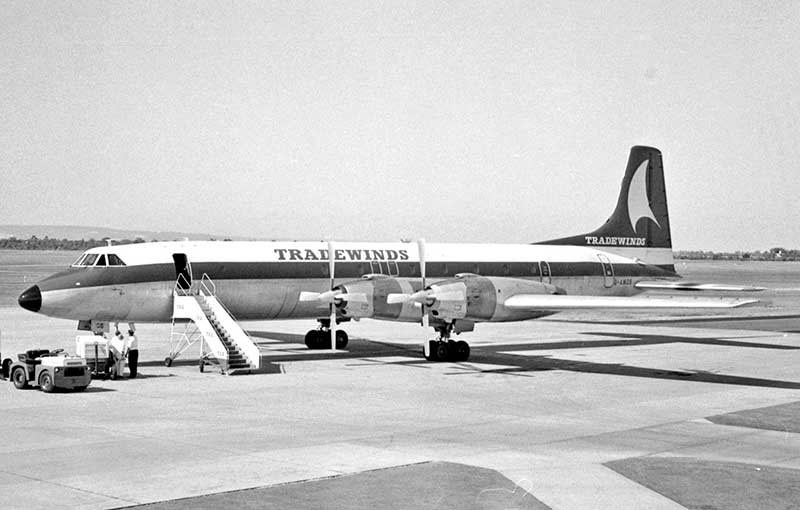
on such flights were Tradewinds G-AWGS in April 1970 and Cargolux TF-LLI in March 1972. Geoff Goodall
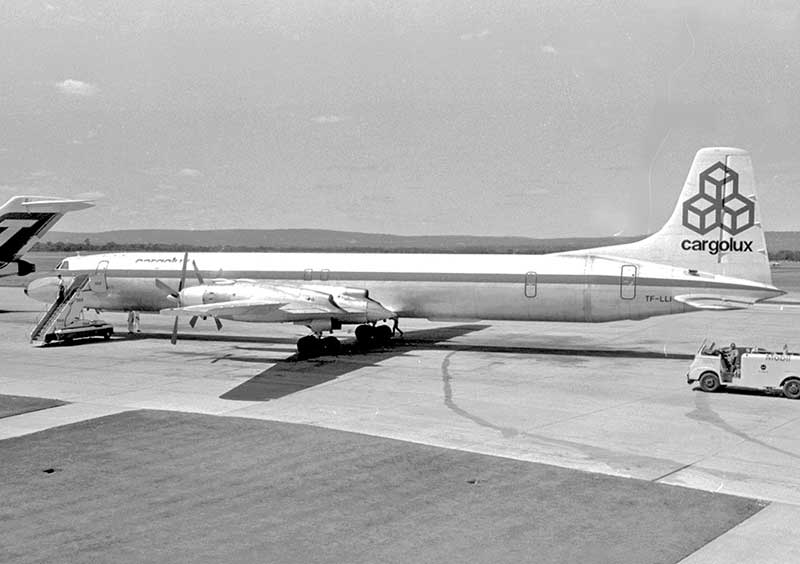

WJ337 seen at Perth on 1 June 1968 departed for home RAF Changi via Cocos later that day. Merv Prime
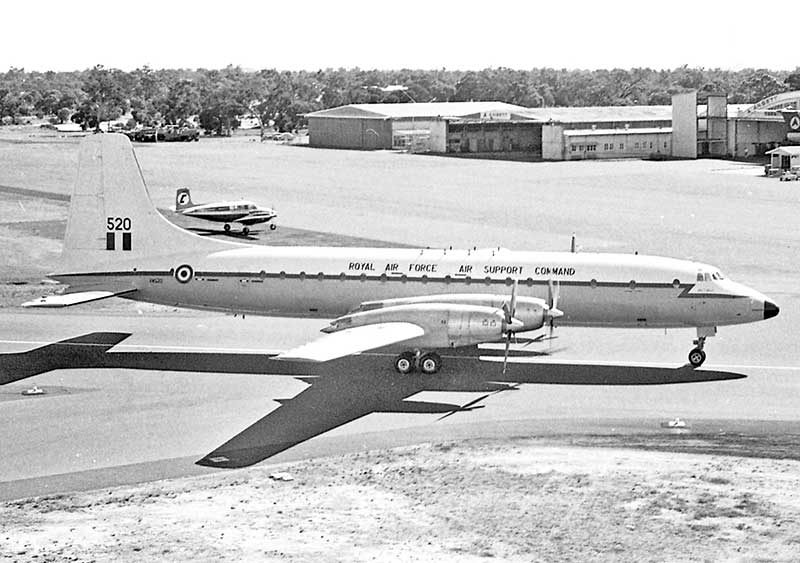
XM521 arrives Perth from Britain via Cocos on 16 February 1971. Geoff Goodall
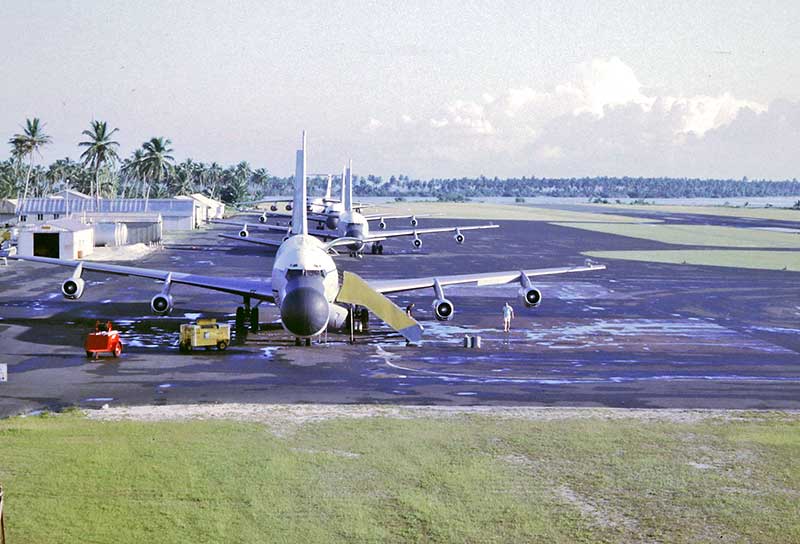
Ocean between ground tracking stations in Australia and Africa. Seen with a KC-135A tanker and C-141A support aircraft.
This and the next three photographs were taken by Colin Hayes
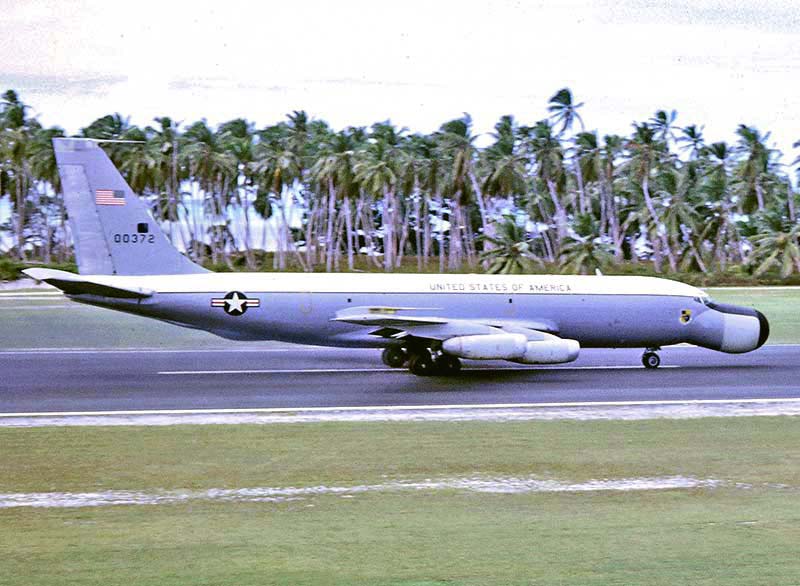
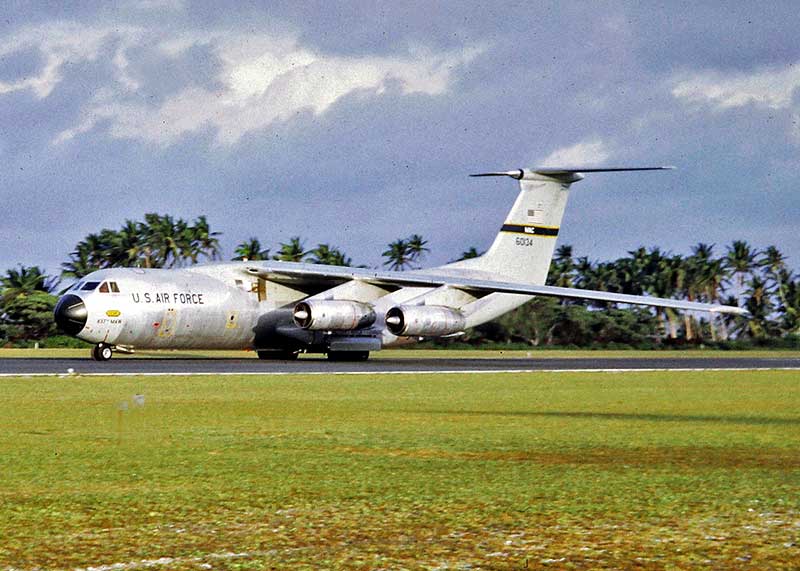
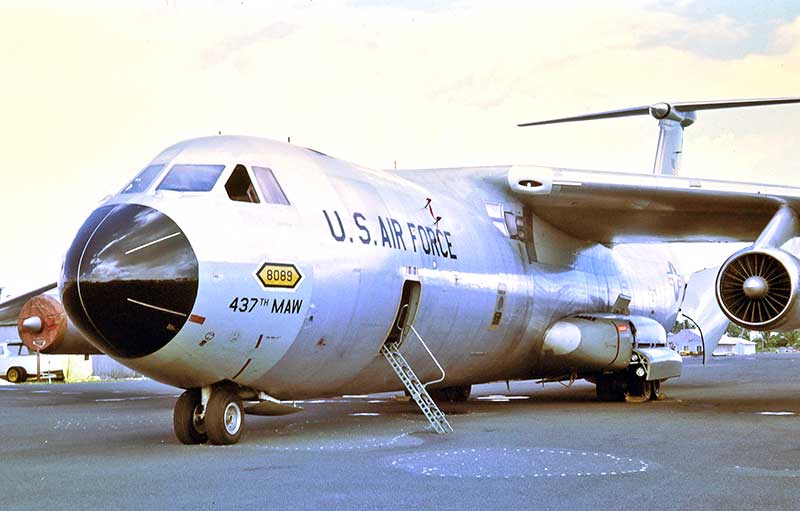
The first service on 11 May 1967 was flown by DC-4 VH-TAB which took 9 hours 30 minutes for the oceanic leg Perrth to Cocos. Ansett-ANA was scheduled to opeate the second return service on 25 May 1967 but their DC-4 was unavailable at that time so TAA was cross-hired to operate it. Unfortunately VH-TAB had an engine failure inbound to Cocos, resulting in a 3 delay while a replacement P&W R-2000 engine was a flown from Melbourne by DC-4 VH-TAE and installed.
In February 1968 Ansett withdrew their DC-4 VH-INY from passenger work for conversion to Cargomaster freighter and cross-hired its Cocos Island runs to TAA until the scheduled introduction of Electras later that year. Both airlines had agreed that by then their Lockheed L.188 Electra services would by sufficiently replaced by new jet airliners to allow an Electra to be diverted to the Cocos fortnightly contract. Electras replaced the DC-4 on the Cocos run from 10 September 1968 when Ansett's VH-RMA flew the route, cutting the Perth-Cocos time to under 6 hours. Improvements in every aspect of the flight were welcomed by islanders. TAA's first Electra service was VH-TLB on 1 October 1968.
From March 1971 a revised contract introduced fortnightly Boeing 727s Perth-Cocos-Perth. The previous charter leg to/from Melbourne was no longer needed. This allowed the airlines to schedule the Cocos return flight between their regular B727 passenger services to Perth, a big improvement to productivity. The first 727 service to Cocos was operated by Ansett 's VH-RMD on 11 March 1971, followed by TAA's VH-TJC on 25 March. The jets cut the ocean crossing time to 3 hours 45 minutes.
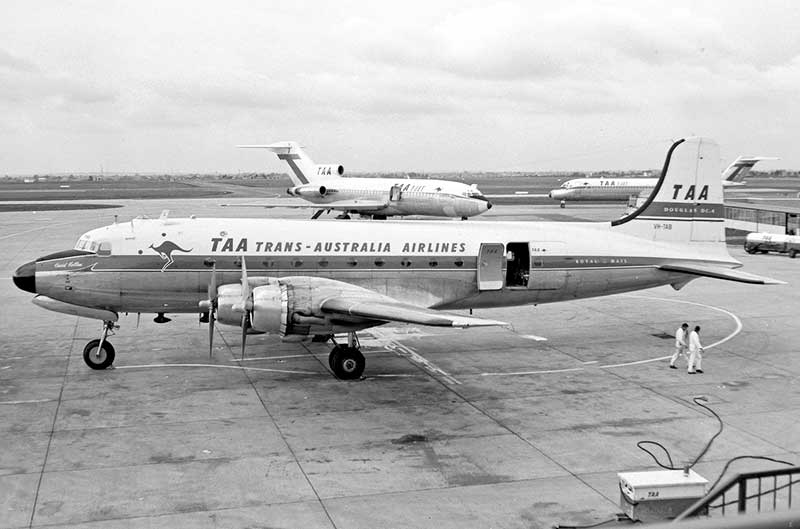
being readied for another courier service to Perth and Cocos. Photo by John Hopton
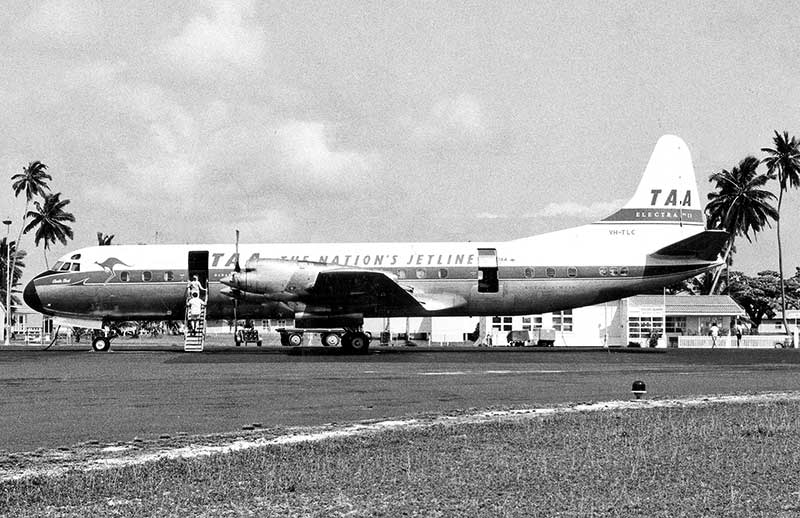
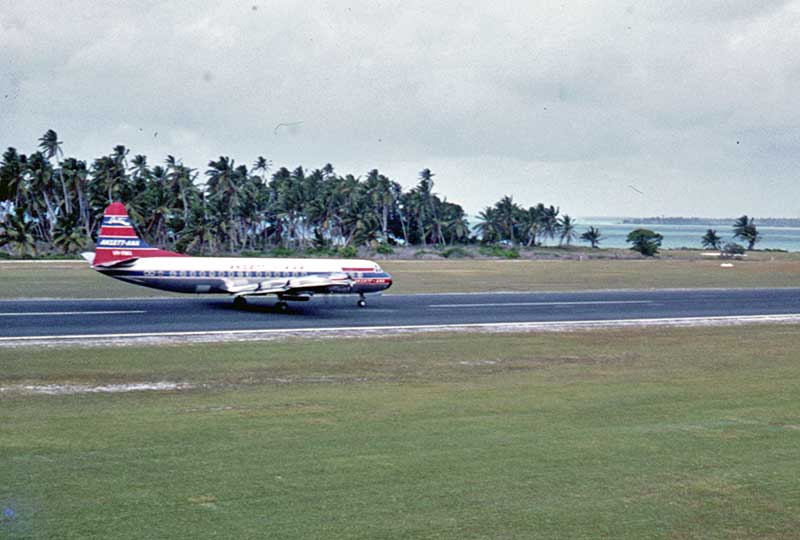
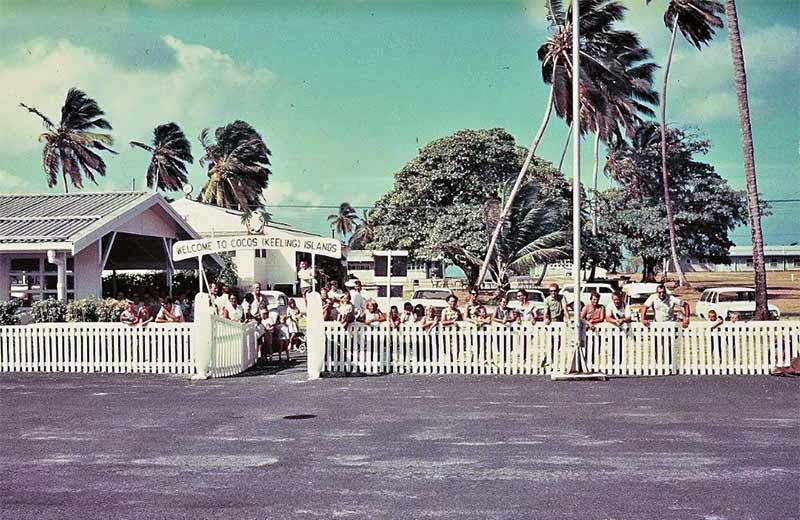

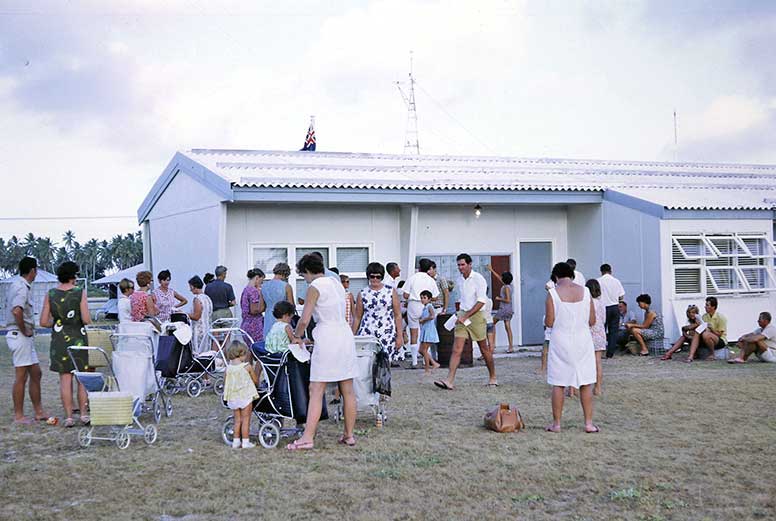
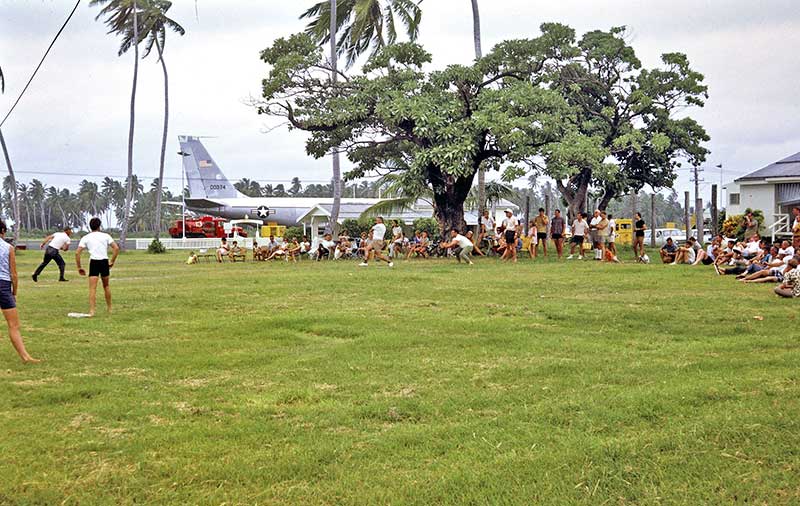

A variety of international air freight operators flew Boeing 727s and DC-8s between Cocos and Australia carrying livestock.
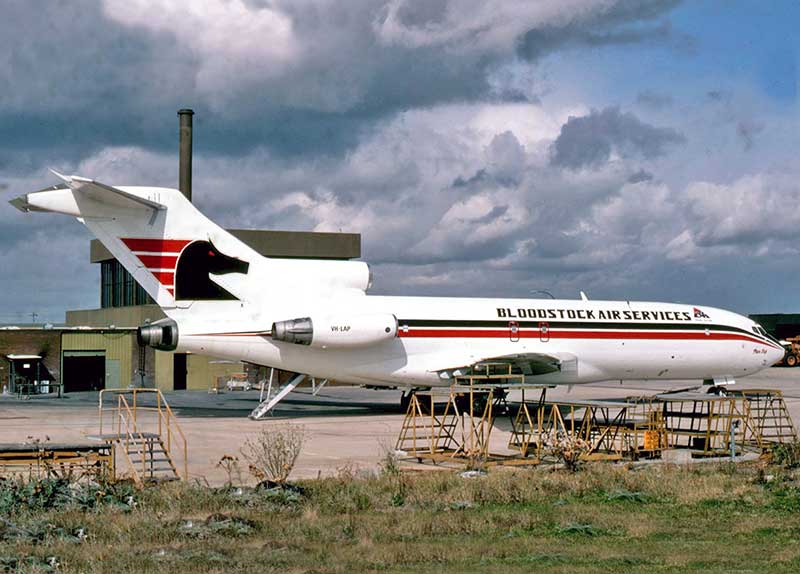
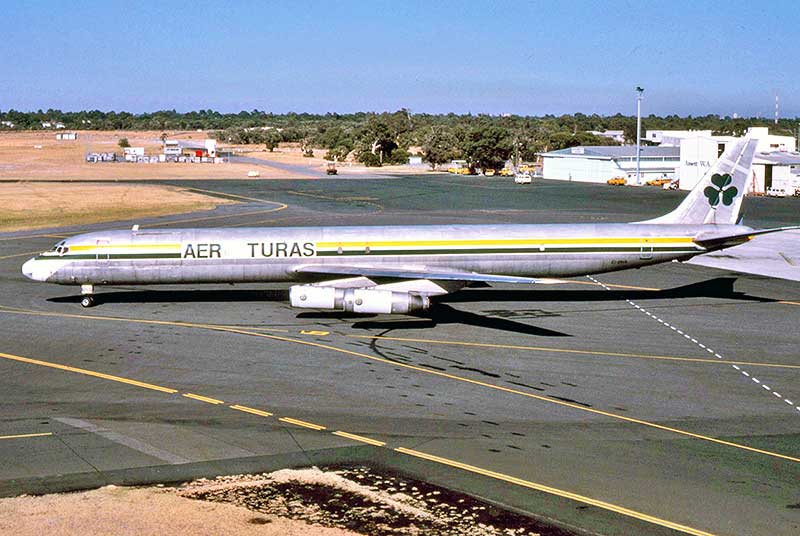
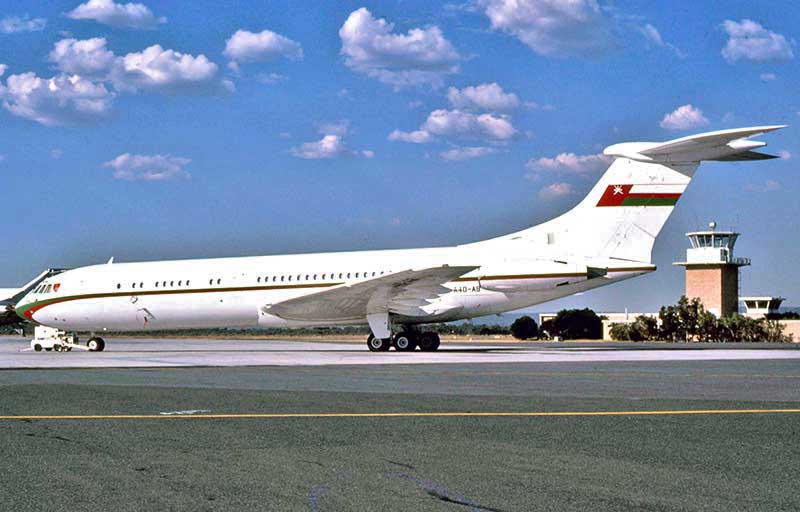
with royal race horses under quarantine before competing at Australian race meetings. These 3 photos by Geoff Goodall
The contract was now named Indian Ocean Territories Air Service. The triangular Perth-Cocos-Christmas-Perth Boeing 727 route commenced on 6 June 1974 when TAA Boeing 727 VH-TJB operated the inaugural run. It was scheduled to depart Perth at midnight after the 727 had flown a revenue service from the Eastern States. Blocks of seats were removed for emergency life rafts. TAA was the sole operator until March 1976 when Ansett joined with alternate fortnightly 727 services.
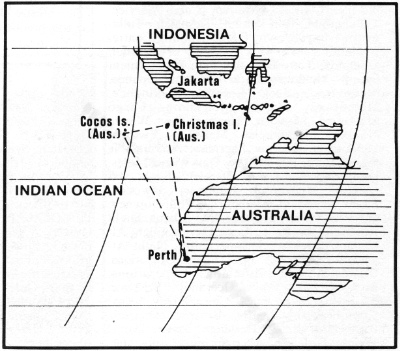
More upheaval was ahead, when in July 1992 the contract was awarded to the lowest bidder, a start-up Perth carrier established the previous year, Indian Ocean Airlines. A Lockheed L.188 Electra N351Q was acquired from USA and registered VH-IOB, but unexpected costly maintenance issues delayed its Australian certification. At the same time the Civil Aviation Safety Authority was extremely reluctant to issue an Airline Operators Certificate to new-start company with modest operational support carrying passengers over oceanic routes in a 33 year old aircraft. Indian Ocean Airlines did not get their Electra into service and were forced to sub-contract Ansett WA to operate on its behalf. The Government courier then reverted to Ansett WA which was fully integrated into Ansett Australia in 1993. Experienced Bae.146 airline operator National Jet Systems was awarded the contract from January 1998 but only a year later it was changed to niche-operator SkyAirWorld in Queensland who were to use two Embraer190 jets but the company suffered a financial collapse before services commenced. The service reverted in April 2009 for another year to National Jet which had recently rebranded as Cobham Aviation. In 2010 the current operator Virgin Australia took over with Embraer 190s, later Airbus A320. The service is licenced as RPT allowing it to carry tourists to recently etablished holiday resorts on Cocos and Christmas Islands. The Australian Government Detention Centre for illegal immigrants on Christmas island is served by separate air service contracts.
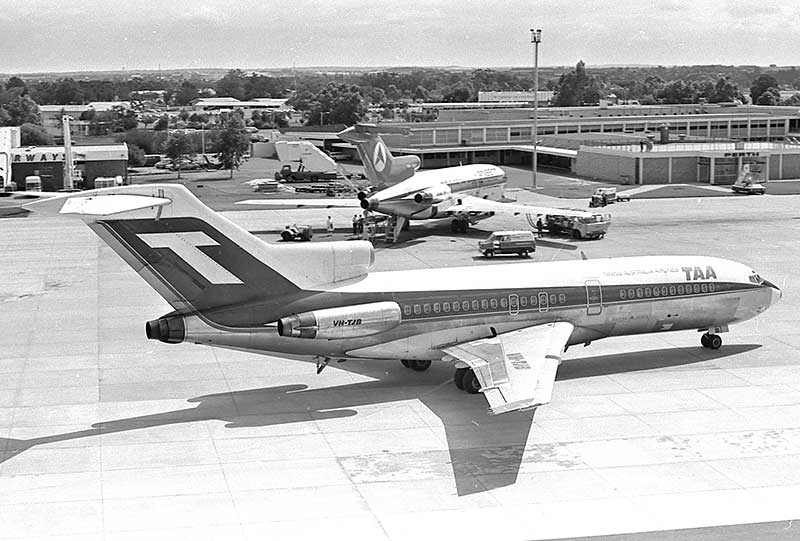


Seen during a refuelling stop at Cairns, Queensland before setting out across the Pacific. These 3 photos by Geoff Goodall
- My thanks to Bob Livingstone, Gordon Reid, Colin Hayes, Tony McGrath.
- Phil Vabre of the Civil Aviation Historical Society, Airways Museum,
Essendon again willingly shared their remarkable photographic collection.
- For readers seeking more detail on the history of Cocos and Christmas
Islands and their air services, Tony McGrath's book In
Tropical Skies published in 2019 is highly recomended: www.tony-mcgrath.com
